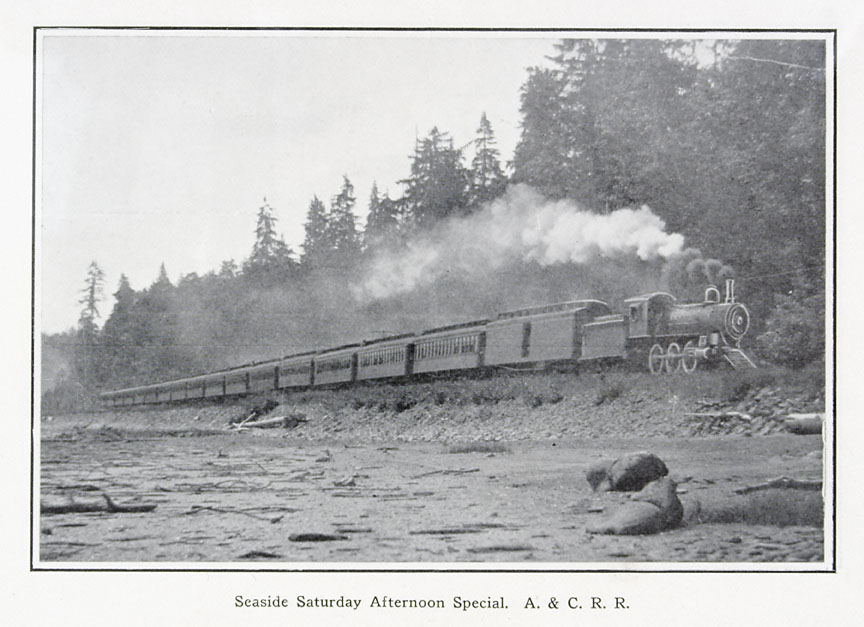- Catalog No. —
- PAM 917-9546 O66
- Date —
- 1904
- Era —
- None
- Themes —
- Geography and Places, Transportation and Communication
- Credits —
- Oregon Historical Society
- Regions —
- Coast Portland Metropolitan
- Author —
- Astoria & Columbia River Railway
Seaside Saturday Afternoon Special
This photograph of an Astoria and Columbia River train is one of many that appear in the railroad’s promotional pamphlet, printed around 1904, entitled, “The Oregon Coast: From Portland to Summer Paradise in Four Hours.” With photographs and short essays, the pamphlet described scenic wonders available on excursion trains along the Columbia River and at coastal destinations in Seaside and Gearhart.
The Astoria and South Coast Railway completed passenger service into Seaside between 1890 and 1891. The railway line originated at a point on Young’s Bay across from Astoria. In 1896, this “Seaside railroad” extended to Astoria via a railway bridge over the bay. The Astoria and Columbia River Railroad (A&CRR) completed a line in 1898 that connected Astoria to Northern Pacific’s tracks in Goble, Oregon. By this time the A&CRR had acquired the Seaside line and signed a ninety-nine year lease with the Northern Pacific for use of the tracks from Goble to Portland. Thus, by 1898, passenger railway service existed from Portland to Seaside. Rates in 1905 were four dollars round trip.
Railroad service into Seaside made the summer resort town more accessible to the upper-middle class. Only a short time previous the Seaside House, the area’s most famous hotel, fostered the resort town’s reputation as a highly fashionable summer destination for the well-to-do. In the interest of selling excursion tickets to the general population, the A&CRR took pains to counter this image of Seaside. “No stern dictates of fashion are obeyed,” read the pamphlet. “…each resident, permanent or transient, is a law unto himself as to dress and conduct, always with due regard for the rights of others.”
The coming of the railroad contributed to the growth of the community. By the turn of the twentieth century, Seaside had evolved as two separate towns, Seaside and West Seaside, each located on opposite sides of the Necanicum River. The combined population in 1902 was 500, but in the summer months residents numbered between five and ten thousand. Besides tourism, industry in the two “Seasides” included a cannery and a lumber company, which operated a box factory and sawmill. The two towns officially merged in 1913. Passenger railroad service discontinued in 1952 as automobile travel and better roads made travel by train obsolete.
Further Reading:
Hanson, Inez Stafford. “When the Train Reached Seaside.” Oregon Historical Quarterly 58, 1957: 127-139.
Austin, Ed and Tom Dill. S.P.& S.: The Spokane, Portland, and Seattle Railway. Edmonds, Wash., 1996.
Written by Sara Paulson, © Oregon Historical Society, 2007.
